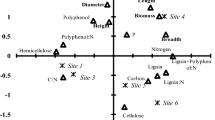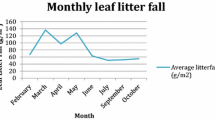Summary
The feeding behaviour of four sympatric isopods from a Hong Kong forest has been investigated. The study included two armadillids (Formosillo raffaelei and Orodillo maculatus) and two philosciids (Burmoniscus ocellatus and Burmoniscus sp.). When given a choice of eight types of litter, all isopod species showed significant dietary selection, and food preferences were similar. Berchemia racemosa (Rhamnaceae) was most readily consumed, followed by Celtis sinensis (Ulmaceac), while feeding rates on Cinnamomum camphora (Lauraceae) were low. The armadillids exhibited a narrower dietary spectrum than the philosciids. All isopods showed significant differences in consumption rates when each litter type was presented separately to them. Cinnamomum camphora was eaten the slowest, while Celtis sinensis and Berchemia racemosa were the top-ranked species. Although patterns of litter ranking based on percentage eaten or feeding rates were similar, all isopods ate more food when given a mixture of leaves than when presented with a single litter type. Assimilation rates were, in general, positively related to feeding rates. On this basis, it appears that assimilation may influence food preference. There were no clear relationships between food preference or feeding rates and ash, calcium, copper, soluble tannin or energy content of the litter. This finding may indicate the benefits of isopods maintaining a mixed diet, consuming certain litter species to meet their calcium or copper requirements and then switching to others so as to meet daily energy needs and to avoid excessive injection of tannins or plant allelochemicals.
Similar content being viewed by others
References
Allen SE, Grimshaw HM, Parkinson JA, Quarmby C (1974) Chemical analysis of ecological materials. John Wiley and Sons, New York, pp 565
Breymeyer A, Brzozowska D (1970) Density, activity and consumption of Isopoda on a Stellario-Deschampsietum meadow. In: Phillipson J (ed) Ecology and Conservation (II). Methods of Study in Soil Ecology, UNESCO, Paris, pp 225–229
Goodwin TW, Mercer EI (1983) Introduction to Plant Biochemistry. Second edition, Pergamon Press, pp 677
Gunnarsson T (1987) Selective feeding on a maple leaf by Oniscus asellus (Isopoda). Pedobiologia 30: 161–166
Harborne JB (1982) Introduction to Ecological Biochemistry. Second edition, Academic Press, New York
Hassall M, Rushton SP (1982) The role of coprophagy in the feeding strategies of terrestrial isopods. Oecologia 53: 374–381
Hassall M, Rushton SP (1984) Feeding behaviour of terrestrial isopods in relation to plant defences and microbial activity. In: Sutton SL, Holdich DM (eds) The Biology of Terrestrial Isopods, Zoological Society of London Symposia, 53, Oxford University Press, Oxford, pp 487–505
Hopkin SP, Martin MH (1984) Heavy metals in woodlice. In: Sutton SL, Holdich DM (eds) The Biology of Terrestrial Isopods, Zoological Society of London Symposia, 53, Oxford University Press, Oxford, pp 143–166
Hryniewicka-Szyfter Z, Storch V (1986) The influence of starvation and different diets on the hindgut of Isopoda (Mesidotea entomon, Oniscus asellus, Porcellio scaber). Protoplasma 134: 53–59
Irons JG, Oswood MW, Bryant JP (1988) Consumption of leaf detritus by a stream shredder: influence of tree species and nutrient status. Hydrobiologia 160: 53–61
Kheirallah AM, El-Sharkawy K (1981) Growth rate and natality of Porcellio olivieri (Crustacea: Isopoda) on different foods. Pedobiologia 22: 262–267
Klekowski RZ, Duncan A (1975) Review of methods for identification of food and for measurement of consumption and assimilation rates In: Grodzinski W, Klekowski RZ, Duncan A (eds) Methods for Ecological Bioenergetics, IBP Handbook, 24, Blackwell Scientific Publications, Oxford, pp 227–261
Ma HHT (1988) The population dynamics, feeding and energetics of four forest isopod (crustacea) species in Hong Kong. Unpublished M Phil thesis, University of Hong Kong, Hong Kong
Nair GA (1976) Food and reproduction of the soil isopod, Porcellio laevis. Int J Ecol Environ Sci 2: 7–13
Ng LS, Ng WF (1983) Dictionary of Biological Alkaloids. Mingshan Press, Taipei, Republic of China, pp 210
Paris OH (1963) The ecology of Armadillidium vulgare (Isopoda: Oniscoidea) in California grassland: food, enemies, and weather. Ecol Monogr 33: 1–22
Rushton SP, Hassall M (1983) Food and feeding rates of the terrestrial isopod Armadillidium vulgare (Latreille). Oecologia 57: 415–419
Sokal RR, Rohlf FJ (1981) Biometry. Second edition. W.H. Freeman, New York, pp 859
Sutton SL (1980) Woodlice. Pergamon Press, Oxford, pp 144
White JJ (1968) Bioenergetics of the woodlouse Tracheoniscus rathkei Brandt in relation to litter decomposition in a deciduous forest. Ecology 49: 694–704
Wood S, Russell D (1987) On the nature of the calcium carbonate in exoskeleton of the woodlouse Oniscus asellus L. (Isopoda, Oniscoidea). Crustaceana 53: 49–53
Zar JH (1974) Biostatistical Analysis. Prentice-Hall, New Jersey pp 620
Author information
Authors and Affiliations
Rights and permissions
About this article
Cite this article
Dudgeon, D., Ma, H.H.T. & Lam, P.K.S. Differential palatability of leaf litter to four sympatric isopods in a Hong Kong forest. Oecologia 84, 398–403 (1990). https://doi.org/10.1007/BF00329766
Received:
Accepted:
Issue Date:
DOI: https://doi.org/10.1007/BF00329766




